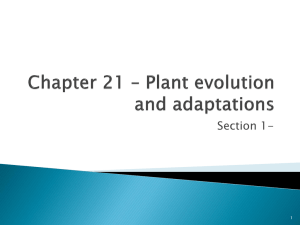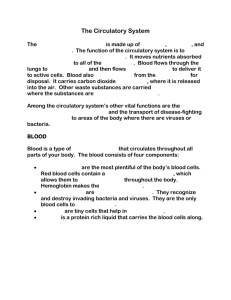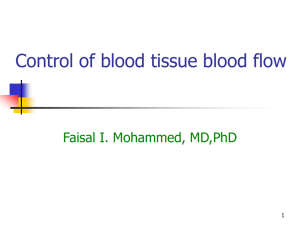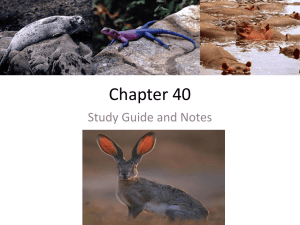Physiology Ch 17 p191-200 [4-25
advertisement
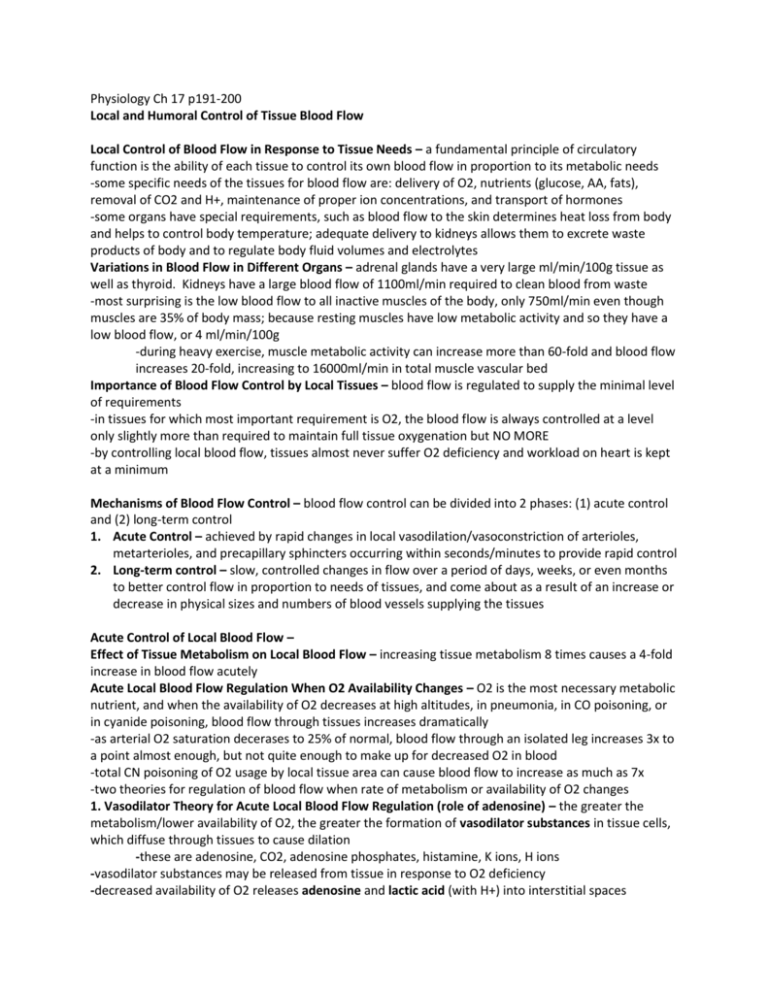
Physiology Ch 17 p191-200 Local and Humoral Control of Tissue Blood Flow Local Control of Blood Flow in Response to Tissue Needs – a fundamental principle of circulatory function is the ability of each tissue to control its own blood flow in proportion to its metabolic needs -some specific needs of the tissues for blood flow are: delivery of O2, nutrients (glucose, AA, fats), removal of CO2 and H+, maintenance of proper ion concentrations, and transport of hormones -some organs have special requirements, such as blood flow to the skin determines heat loss from body and helps to control body temperature; adequate delivery to kidneys allows them to excrete waste products of body and to regulate body fluid volumes and electrolytes Variations in Blood Flow in Different Organs – adrenal glands have a very large ml/min/100g tissue as well as thyroid. Kidneys have a large blood flow of 1100ml/min required to clean blood from waste -most surprising is the low blood flow to all inactive muscles of the body, only 750ml/min even though muscles are 35% of body mass; because resting muscles have low metabolic activity and so they have a low blood flow, or 4 ml/min/100g -during heavy exercise, muscle metabolic activity can increase more than 60-fold and blood flow increases 20-fold, increasing to 16000ml/min in total muscle vascular bed Importance of Blood Flow Control by Local Tissues – blood flow is regulated to supply the minimal level of requirements -in tissues for which most important requirement is O2, the blood flow is always controlled at a level only slightly more than required to maintain full tissue oxygenation but NO MORE -by controlling local blood flow, tissues almost never suffer O2 deficiency and workload on heart is kept at a minimum Mechanisms of Blood Flow Control – blood flow control can be divided into 2 phases: (1) acute control and (2) long-term control 1. Acute Control – achieved by rapid changes in local vasodilation/vasoconstriction of arterioles, metarterioles, and precapillary sphincters occurring within seconds/minutes to provide rapid control 2. Long-term control – slow, controlled changes in flow over a period of days, weeks, or even months to better control flow in proportion to needs of tissues, and come about as a result of an increase or decrease in physical sizes and numbers of blood vessels supplying the tissues Acute Control of Local Blood Flow – Effect of Tissue Metabolism on Local Blood Flow – increasing tissue metabolism 8 times causes a 4-fold increase in blood flow acutely Acute Local Blood Flow Regulation When O2 Availability Changes – O2 is the most necessary metabolic nutrient, and when the availability of O2 decreases at high altitudes, in pneumonia, in CO poisoning, or in cyanide poisoning, blood flow through tissues increases dramatically -as arterial O2 saturation decerases to 25% of normal, blood flow through an isolated leg increases 3x to a point almost enough, but not quite enough to make up for decreased O2 in blood -total CN poisoning of O2 usage by local tissue area can cause blood flow to increase as much as 7x -two theories for regulation of blood flow when rate of metabolism or availability of O2 changes 1. Vasodilator Theory for Acute Local Blood Flow Regulation (role of adenosine) – the greater the metabolism/lower availability of O2, the greater the formation of vasodilator substances in tissue cells, which diffuse through tissues to cause dilation -these are adenosine, CO2, adenosine phosphates, histamine, K ions, H ions -vasodilator substances may be released from tissue in response to O2 deficiency -decreased availability of O2 releases adenosine and lactic acid (with H+) into interstitial spaces -these substances can cause intense acute vasodilation/responsible for local blood flow regulation -CO2, lactic acid, and K+ tend to increase in tissues when blood flow is reduced and cell metabolism continues at the same pace, or when metabolism is increases -vasodilation causes increased tissue blood flow and returns tissue concentration of metabolites -adenosine is important for controlling local blood flow; when minute amounts of adenosine are released from heart muscle cells when coronary blood flow becomes too little, this causes enough local vasodilation in heart to return coronary blood flow back to normal -when heart becomes more active than normal and heart’s metabolism increases, it causes an increased utilization of O2 decreased O2 concentration in heart muscle cells degradation of ATP increases release of adenosine -this adenosine leaks out of heart muscle cells to cause coronary vasodilation to increase flow to supply the increased nutrient demands of active heart 2. Oxygen Lack Theory for Local Blood Flow Control – also called the nutrient lack theory. O2 is required as one of the metabolic nutrients to cause vascular muscle contraction; in the absence of adequate O2, it is reasonable to believe that blood vessels simply would relax and naturally dilate -increased utilization of O2 in tissues as a result of increased metabolism could decrease availability of O2 to smooth muscle fibers in local blood vessels to cause vasodilation -number of precapillary sphincters open in a metarteriole is proportional to requirements of tissue for nutrition -precapillary sphincters and metarterioles open and close cyclically several times per minute, with duration of open phases being proportional to metabolic needs of the tissues for O2 -cyclical opening and closing is called vasomotion -because smooth muscle requires O2 to remain contracted, the strength of contraction of sphincters would increase with an increase in O2 concentration -when O2 is gone and O2 concentration falls low, sphincters would open to begin the cycle again -either a vasodilator substance theory or O2 lack theory can explain acute local blood flow regulation Possible role of Other Nutrients Besides O2 in Control of Local Blood Flow – lack of glucose in perfusing blood can cause local tissue vasodilation, or with AA or fatty acid deficiencies -vasodilation occurs in the vitamin deficiency beriberi, in which patient has deficiencies of vitamin B substances thiamine, niacin, and riboflavin -in this disease, peripheral vascular flow everywhere increases 2-3x because all these vitamins are necessary for O2-induced phosphorylation, and so a deficiency would increase vasodilation Special Examples of Acute “Metabolic” Control of Local Blood Flow – 1. Reactive Hyperemia – when blood supply is blocked for set time and then unblocked, blood flow increases immediately to 4-7x normal and will continue (the longer blocked, the longer the flow), called reactive hyperemia a. Lack of flow releases vasodilator factors; after short periods of vascular occlusion, extra blood flow during reactive hyperemia phase lasts long enough to repay almost exactly the tissue O2 deficit that has accrued during the period of occlusion 2. Active Hyperemia – when tissue becomes active, such as exercising muscle, a GI gland during hypersecretory period, or brain during mental activity, rate of blood flow through tissue increases; increase in local metabolism causes cells to eat nutrients rapidly and release vasodilator substances to dilate local blood vessels and increase local flow to receive more nutrients required to sustain a new level of function “Autoregulation” of Blood Flow When Arterial Pressure Changes from Normal – “Metabolic” and “Myogenic” Mechanisms – a rapid increase in arterial pressure causes immediate rise in blood flow, but in less than a minute, blood flow in most tissues returns almost to normal level even with increased pressure acutely; called autoregulation of blood flow. -Two views have been proposed to explain acute autoregulation mechanism, the metabolic theory and the myogenic theory 1. Metabolic Theory – when arterial pressure increases, excess flow provides too much O2 and too many nutrients and washes out vasodilators, causing tissue vasoconstriction and normal flow 2. Myogenic Theory – sudden stretch of small blood vessels cause smooth muscles to contract; it has been proposed that when high arterial pressure stretches the vessel, this causes reactive vascular constriction that reduces blood flow back to normal a. At low pressures, the degree of stretch is less, and smooth muscle relaxes, reducing vascular resistance and helps return flow toward normal b. Myogenic response is inherent to vascular smooth muscle and occurs without neural or hormonal influences c. Myogenic contraction is initiated by stretch-induced vascular depolarization rapidly increases Ca entry from extracellular fluid causing them to contract d. Changes in vascular pressure can open or close other ion channels to affect contraction e. This mechanism is important in preventing excessive stretch when BP is increased Special Mechanisms for Acute Blood Flow in Specific Tissues – many tissues differ, here they are: 1. Kidneys – blood flow is vested to a great extend in a mechanism called tubuloglomerular feedback, where composition of fluid in early distal tubule is detected by an epithelial structure of distal tubule called the macula densa (located where distal tubule lies adjacent to afferent and efferent arterioles at the nephron juxtaglomerular apparatus) a. When too much fluid filters from blood into tubular system, feedback signals from macula densa cause constriction of afferent arterioles to reduce renal blood flow and glomerular filtration rate back to normal 2. Brain – in addition to control by O2, increases in concentrations of CO2 and H+ cause rapid washout of the excess ions from the brain; important because level of excitability of brain is highly dependent on exact control of both CO2 and H ion concentration 3. Skin – blood flow is closely linked to regulation of body temperature; cutaneous and subcutaneous flow regulates heat loss from body by metering the flow of heat from core to surface of body a. Skin blood flow is controlled by CNS through sympathetics, and the skin can change blood flow very readily; when body temp is reduced, skin blood flow decreases; when body is heated, skin blood flow may increae many fold Control of Tissue Blood Flow by Endothelial-Derived Relaxing or Constricting Factors – endothelial cells can synthesize several substances that affect degree of relaxation or contraction of a vessel wall 1. Nitric Oxide (Vasodilator released from healthy endothelium) – most important factor is nitric oxide (NO), a lipophilic gas released from endothelial cells in response to stimuli a. Nitric oxide synthase (NOS) enzymes in endothelial cells synthesize NO from arginine and oxygen and by reduction of inorganic nitrate b. After diffusing out of cell, NO has a half life of 6 seconds and acts in local tissues c. NO activates soluble guanylate cyclases in vascular smooth muscle cells to convert cGTP to cGMP + activation of cGMP-dependent protein kinase (PKG) causing vessel to relax + dilate d. When blood flows through arteries and arterioles, this causes shear stress on endothelial cells because of viscous drag of blood against vascular walls; this increases release of NO, which relaxes the blood vessels e. Changes in microcirculation stimulate upstream arteries to release NO to increase diameters of larger vessels whenever microvascular circulation increases downstream f. NO synthesis and release is ALSO stimulated by some vasoconstrictors, such as angiotensin II, which binds to receptors on endothelial cells; increased NO protects against excessive vasoconstriction g. When endothelial cells are damaged by chronic hypertension or atherosclerosis, impaired NO synthesis may contribute to excessive vasoconstriction and worsening of hypertension h. Nitroglycerin treats angina pectoris – chest pain caused by ischemia of heart muscle; these drugs release NO and evoke dilation of blood vessels throughout the body i. Drugs that inhibit cGMP specific phosphodiesterase-5 (PDE-5, an enzyme that degrades cGMP) act to prolong actions of NO to cause vasodilation; also treats erectile dysfunction i. Erection is caused by parasympathetic nerves through pelvic nerves to penis, where acetylcholine and NO are released; by preventing degradation of NO, PDE-5 inhibitors enhance dilation of blood vessels in penis and aid in erection 2. Endothelin – A Powerful Vasoconstrictor Released from Damaged Endothelium – endothelin is a large, 21 AA peptide that only requires a little bit to cause powerful vasoconstriction; it is present in endothelial cells of all blood vessels but greatly increases when vessels are injured a. Usual stimulus for release is damage to endothelium, such as crushing of tissues or injecting a traumatic chemical into vessel b. Resulting release of endothelin and subsequent vasoconstriction helps prevent extensive bleeding from arteries as large as 5mm in diameter c. Increase in endothelin also contributes to vasoconstriction when endothelium is damaged by hypertension; drugs that block endothelin receptors have been used to treat pulmonary hypertension Long-Term Blood Flow Regulation – even after activation of all the acute mechanisms, blood flow is usually adjusted only about ¾ of the way to exact additional requirements of the tissues -over a period of hours, days and weeks, long-term local blood flow regulation develops in addition to acute control to give a more complete control of flow -this is important when metabolic demands of a tissue change; thus if a tissue becomes chronically overactive and requires increased quantities of O2 and nutrients, arterioles and capillaries increased both in NUMBER and in SIZE within a few weeks to match the needs of the tissue Mechanism of Long-Term Regulation – Change in “Tissue Vascularity” – long term control is carried out through changing the vascularity of the tissues; if metabolism in tissue increased for a prolonged period, vascularity increases, a process called angiogenesis; if metabolism is decreased, vascularity decreases -there is physical reconstruction of vasculature to meet the needs of the tissues, and occurs rapidly (within days) in young animals -it also occurs rapidly in new growth tissue, such as scar tissue and cancerous tissue, but it occurs slower in old, well-established tissues -the time required for long-term regulation to take place may only be a few days in the neonate or as long as months in the elderly person -final degree of response is much better in younger tissues than in older Role of O2 in Long-Term Regulation – O2 is important for both acute and long-term control, such as when people live at high altitudes having increased vascularity in their tissues Importance of Vascular Endothelial Growth Factor (VEGF) in Formation of New Blood Vessels – three factors that contribute to growth of new vessels: VEGF, fibroblast growth factor (FGF), and angiogenin -it is the deficiency of tissue O2 or other nutrients that leads to formation of angiogenic factors -all angiogenic factors promote new vessel growth in the same way; they cause new vessels to sprout from other small vessels -first step is dissolution of basement membrane of endothelial cells at sprouting point rapid reproduction of endothelial cells that stream outward through vessel wall in extended cords directed toward source of angiogenic factor -cells in each cord continue to divide and fold over into a tube -tube connects with another tube budding from another donor vessel and forms a capillary loop through which blood begins to flow -if flow is great enough, smooth muscle cells eventually invade the wall, so some of the new vessels grow to be new arterioles or venules or even larger vessels -other substances like steroid hormones have the OPPOSITE effect on small blood vessels, occasionally even causing dissolution of vascular cells and disappearance of vessels -therefore, blood vessels can disappear when not needed -peptides produced in tissues can also block growth, such as angiostatin (fragment of plasminogen), and endostatin (breakdown product of collagen type XVII) Vascularity is Determined by Maximum Blood Flow Need, Not by Average Need – during heavy exercise the need for whole body blood flow increases 6-8x the resting flow -this excess may not be required for more than a few minutes each day, but it can cause enough VEGF to be formed by muscles to increase their vascularity as required -after extra vascularity develops, extra blood vessels normally remain vasoconstricted, opening to allow extra flow only when appropriate stimuli such as O2 lack, nerve vasodilatory stimuli, or other stimuli call forth the required extra flow Development of Collateral Circulation – when artery/vein is blocked in any tissue, a new vascular channel usually develops around the blockage to allow partial resupply of blood to affected tissues -first stage is dilation of small vascular loops that already connect vessel above blockage to the vessel below; dilation occurs within first minute, indicating that the dilation is mediated by metabolic factors that relax muscle fibers of small vessels involved -after initial opening of collateral vessels, blood flow is still less than 25% that is needed to supply all tissue needs; further opening occurs within a few hours and within 1 day as much as half the tissue needs may be met -collateral vessels continue to grow for many months, almost always forming multiple small collateral channels rather than one single large vessel, and under resting conditions, blood flow can return to normal; but new channels cannot handle strenuous activity -acute part of control being rapid metabolic dilation, followed chronically by growth and enlargement of new vessels over a period of weeks and months -most important example is collateral blood vessels after thrombosis of coronary arteries Humoral Control of Circulation – control by substances secreted or absorbed into body fluids, such as hormones and locally produced factors; some formed by special glands and act on the whole body and others are formed in local tissue areas and cause local dilation only Vasoconstrictor Agents 1. Norepinephrine and Epineprhine – norepinephrine is a powerful vasoconstrictor hormone, while epinephrine is a less powerful one and can even cause mild vasodilation in some tisseus (coronary arteries during increased heart activity a. When sympathetic nervous system is stimulated in most parts of body during stress or exercise, sympathetic nerve endings release norepinephrine, which excites the heart and contracts veins and arterioles b. In addition, sympathetic nerves to adrenal medullae cause glands to secrete both norepinephrine and epinephrine into blood to cause same effects on circulation everywhere 2. Angiotensin II – a powerful vasoconstrictor substance (1 millionth of a gram can increase arterial pressure about 50mmHg or more) a. Effect of angiotensin II is to constrict powerfully the small arterioles, which can severely depress blood flow to an isolated tissue area b. Normally acts on many arterioles of the body at the same time to increase total peripheral resistance, thereby increasing arterial pressure 3. Vasopressin – also called antidiuretic hormone (ADH) is even more powerful than angiotensin II as a vasoconstrictor; formed in nerve cells in hypothalamus and is transported to posterior pituitary, where it is finally secreted into the blood a. Only minute amounts of vasopressin are secreted, and can bring BP up to normal after severe hemorrhage b. Vasopressin has major function to increase H2O reabsorption by renal tubules back into blood and help control body fluid volume (that’s why it’s called antidiuretic hormone) Vasodilator Agents 1. Bradykinin – kinins cause powerful vasodilation when formed in blood and tissue fluids of organs a. Kinins are small polypeptides that are split away by proteolytic enzymes from alpha2globulins in plasma or tissue fluids b. An important proteolytic enzyme is kallikrein which is present in blood and tissue fluids in an inactive form; inactive kallikrein is activated by maceration of blood, tissue inflammation, or by other effects on blood or tissues i. As kallikrein is activated, it acts on alpha2-globulin to release a kinin called kallidin which is then converted to brdykinin c. Once formed, Bradykinin persists only a few minutes because it is inactivated by a carboxypeptidase or converting enzyme (same enzyme as controls angiotensin) d. Activated kallikrein enzyme is destroyed by kallikrein inhibitor present in body fluids e. Bradyknin causes both powerful arteriolar dilation AND increased capillary permeability, which can cause edema 2. Histamine – released in every tissue of body upon damage or inflammation, or allergic reaction. Most histamine is derived from mast cells in damaged tissues and from basophils in the blood a. Histamine has powerful vasodilator effect on arterioles and has the ability to increase capillary permeability, allowing leakage of fluid and protein into tissues i. Pathologic histamine release can cause edema, prominent in allergic reactions Vascular Control by Ions and Other Chemical Factors – many different ions and chemical factors can dilate or constrict blood vessels, and do not act on overall circulation 1. increase in Ca concentration = VASOCONSTRICTION (stimulates smooth muscle contraction) 2. increase in K concentration = VASODILATION due to inhibition of smooth muscle contraction 3. increase in Mg = POWERFUL VASODILATION, Mg inhibits smooth muscle contraction 4. increase in H (decrease pH) = dilation of arterioles; slight decrease in H = constriction 5. Anions like acetate and citrate can cause VASODILATION 6. Increase in CO2 causes moderate VASODILATION, but BIG VASODILATION IN BRAIN; CO2 in the blood acting on brain vasomotor center indirectly causes widespread vasoconstriction through a sympathetic vasoconstrictor system Most Vasodilators or Vasoconstrictors Have Little Effect on Long-Term Blood Flow Unless they Alter Metabolic Rate of Tissues – in most cases, tissue blood flow and cardiac output are not substantially altered except for 1 day or 2 -because tissues can AUTOREGULATE their own blood flow according to metabolic needs of tissues -vasoconstrictors may cause decreases in blood flow transiently, but has little long-term effect if it does not alter metabolic rate of tissues; same goes for vasodilators -therefore, blood flow is generally regulated according to specific needs of tissues as long as arterial pressure is adequate to perfuse the tissues
